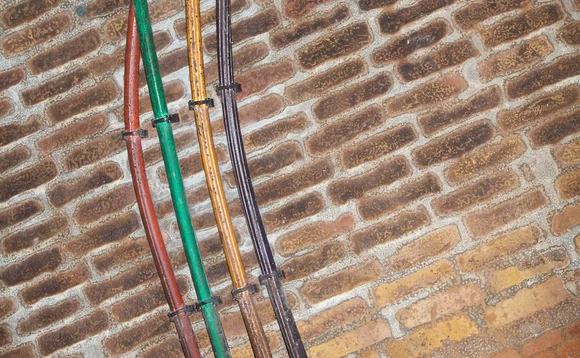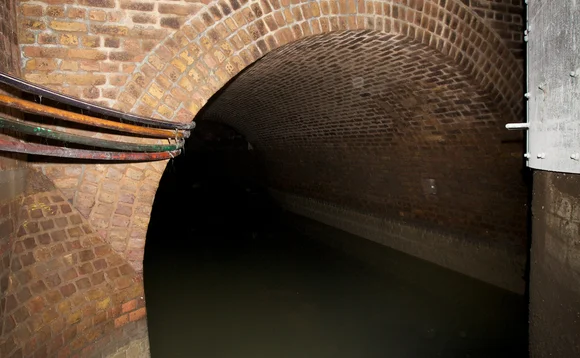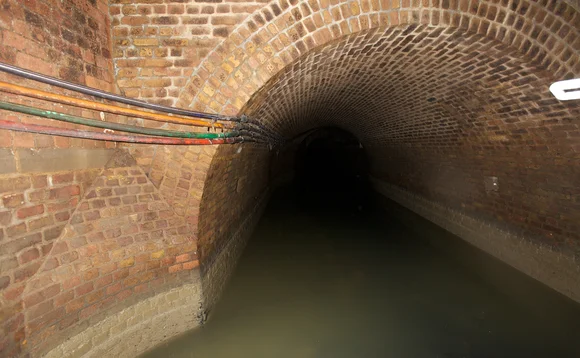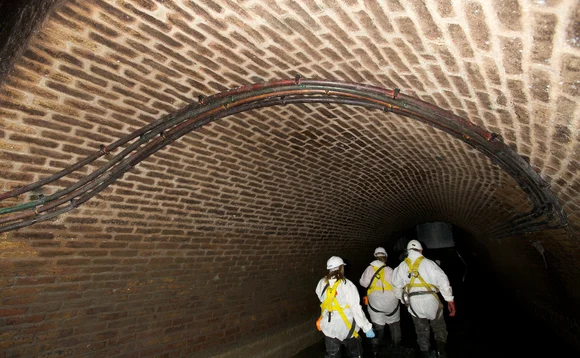Beneath London, Data Flows Through the City’s Sewers




They should be.
"That bundle behind you," says a Thames Water representative, pointing at four non-descript cables on the wall, as he leads a troop of journalists through a section of the system near Hackney Wick, in East London. "That's the Isle of Dogs."
For those unfamiliar with the geography of the UK's capital, the Isle of Dogs contains Canary Wharf, the second financial heart of the city, next to the City itself. Those few cables contain all of the information on the area's network—essentially, all of the major banks' trading operations, media broadcasts and wire updates, regulatory activities and more, that are based in the E14 postal code area and connected to the wires in front of us.
Fifty Feet Under
The fiber optic network is operated by Geo Networks, in partnership with Thames Water. The firm services a number of industries, including financial services, and says that its network provides a unique proposition for prospective clients that require high levels of security and reliability in their connectivity infrastructures.
"There's a massive advantage to our network through using the Victorian sewer system," says Rob Williams, sales director for the finance sector at Geo Networks. "It runs, at the shallowest end, at around four meters beneath the roadway, through to 12 to 15 meters. It gives you an incredible element of security to the network."
"The strangest thing I've ever found," says the Thames Water representative, considering a question from one of the group. "One of my colleagues found a hand grenade once."
Despite the levels of protection placed around computer systems at banks and exchanges, both physical and virtual, huge problems with communications infrastructure are often encountered through relatively mundane situations, such as a cable being cut accidentally during civil works, or through metal theft. In contrast to the depth of Geo's Metro network, much of the cabling for fiber optics in the capital is directly beneath the road, and above water mains, requiring road workers to either work around it or cut through to reach critical systems.
"At the last count that we did, for 2011 and 2012, there were over 406,000 road works that happened within the capital that year. If you relate that back to the amount of streets in that area, it's the equivalent of each street being worked on six times. Now, a lot of those are residential, which won't feel the effect of that as much. The load-bearing streets, for want of a better word, get dug up a lot,” Williams says.
Point A to Point B, via C
While the sewer provides what Williams describes as 100 percent security for the cabling, there are restrictions. The network has to follow the sewer system, and Geo is forced to dig up to connect clients. As well as that, Thames Water is obliged to provide a response time, 24/7, within four hours, for any disruption, so the routes must be accessible for engineers. This, however, doesn't enormously limit the network, given its broad coverage from Stratford in the East End, through to the far west of London, and similar on the north–south axis. Clients in the financial services sector include banks, hedge funds, exchanges and others.
"We're a high-bandwidth provider," says Williams. "Generally speaking, that predicates headquarters connectivity back to a datacenter. So if you're looking at a retail network for branch connectivity, it doesn't fit that well, as it's a low-bandwidth activity. But if you're looking for connectivity to a datacenter or an exchange, that works well."
The low-latency aspect of connection, Williams says, depends on the location and its approximate A-to-B route through the sewer network. Laying the cables themselves, though, is not the easiest job. The group, including Waters, spent approximately half an hour underground, and the heat was palpable, even on a cool, rainy autumn day. Engineers will typically spend shifts of two to three hours before being rotated out, and sewer flow may have to be diverted to allow them to work. That doesn't even cover the alarming items sometimes encountered in the water itself.
"The strangest thing I've ever found?" says the Thames Water representative, considering a question from one of the group. "One of my colleagues found a hand grenade once."
Only users who have a paid subscription or are part of a corporate subscription are able to print or copy content.
To access these options, along with all other subscription benefits, please contact info@waterstechnology.com or view our subscription options here: https://subscriptions.waterstechnology.com/subscribe
You are currently unable to print this content. Please contact info@waterstechnology.com to find out more.
You are currently unable to copy this content. Please contact info@waterstechnology.com to find out more.
Copyright Infopro Digital Limited. All rights reserved.
As outlined in our terms and conditions, https://www.infopro-digital.com/terms-and-conditions/subscriptions/ (point 2.4), printing is limited to a single copy.
If you would like to purchase additional rights please email info@waterstechnology.com
Copyright Infopro Digital Limited. All rights reserved.
You may share this content using our article tools. As outlined in our terms and conditions, https://www.infopro-digital.com/terms-and-conditions/subscriptions/ (clause 2.4), an Authorised User may only make one copy of the materials for their own personal use. You must also comply with the restrictions in clause 2.5.
If you would like to purchase additional rights please email info@waterstechnology.com
More on Trading Tech
FCA eyes equities tape, OpenAI and Capco team up, prediction markets gain steam, and more
The Waters Cooler: More tokenization, Ediphy lawsuit updates, Rimes teams up with Databricks, and more in this week’s news roundup.
Buy-side data heads push being on ‘right side’ of GenAI
Data heads at Man Group and Systematica Investments explain how GenAI has transformed the quant research process.
Technology alone is not enough for Europe’s T+1 push
Testing will be a key component of a successful implementation. However, the respective taskforces have yet to release more details on the testing schedules.
MayStreet founder says LSEG abandoned integration in new court filing
In response to LSEG’s motion to dismiss a lawsuit filed by the founder of one of its acquired companies, lawyers for Patrick Flannery have offered more details around communications between MayStreet and the exchange group.
As outages spread, it’s time to rethink how we view infrastructure technology
Waters Wrap: First AWS and then Azure. And these are only the most recent of significant outages. Anthony says a change is needed when it comes to calculating server migrations.
LLM firms come for finance, BMLL gets bought, LSEG users get Preqin feeds, and more
The Waters Cooler: Tradeweb completes fully electronic RFM swaptions trade, IBM cashes in on digital asset mania, and more frights and delights in this week’s news roundup.
TMX’s CEO wonders if tokenization is a ‘solution looking for a problem’
While acknowledging the potential of tokenizing securities, John McKenzie said regulators shouldn’t move too fast, and let customer demand drive adoption.
Bolsa Mexicana embarks on multi-year modernization project
Latin America’s second largest exchange is embracing cloud and upgrading its infrastructure in a bid to bolster its global standing, says CEO.







